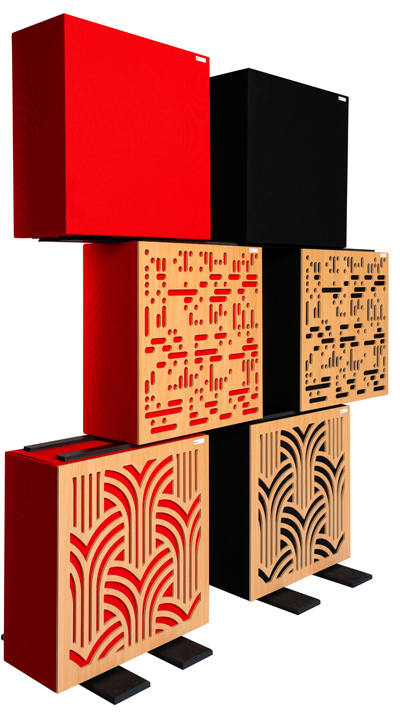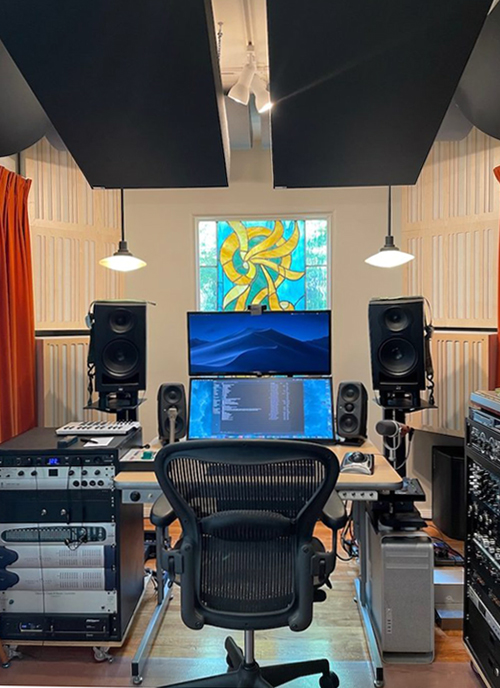
Barry's Mix Magazine Equipment And Software Reviews
Barry's Massive Discography And Engineering Career
Barry's Music Connection Magazine Reviews
Barry's Resolution Magazine Reviews
GIK Acoustics Sound Blocks
Reviewer Barry Rudolph puts GIK Acoustics' Sound Blocks to the test in his own facility and finds the effort was worth it.
By Barry Rudolph
 |
| GIK Acoustics Sound Blocksk |
GIK Acoustics' Sound Blocks are the company's latest aftermarket acoustic treatment product, designed to offer powerful acoustic absorption in modular "blocks", with a range of (selectable) source-facing diffusion plates mounted on the front.
The four Sound Blocks sent to me for evaluation came in two versions: Two were basic-looking, fabric-covered modules and two had front plates that matched my existing GIK Alpha 4A panels already mounted in the corners of my mix room. The 4-inch-thick Alpha panels have 1D, binary-style diffusor plates with vertical slats on the front that spread sound reflections out in a horizontal plane.
A Sound Block is essentially a wood frame filled with Knauf ECOSE, an environmentally friendly, fabric-wrapped, sound absorption insulation material. Because a Sound Block is nearly 11 inches thick, it has a broadband absorptive effect on frequencies down to 60 Hz. Although these are velocity absorbers that mostly absorb middle and high frequencies, you may order them with GIK's Range Limiter that "tilts" the absorption toward the bass, with less absorption in the treble range.
Each Sound Block measures 23 x 23 x 10.5 inches (WxHxD), weighs about 22 pounds, and can be stacked and used anywhere within a room.
Installing Sound Blocks
 |
| Barry Rudolph's Tones 4 $ Studios Control Room |
My entire mix room measures 19.29 x 9.44 x 8.2 feet (LxWxH), while my Kali Audio IN-8 three-way (front-ported) monitors sit on Sound Anchor ADJ2 stands positioned on either side and in front of my 42-inch-wide desktop and about 36 inches away from the front wall. The focus of all acoustic treatment panels is the listening position in front of my desktop.
I prefer the liveliness of the hardwood floor under my chair, but I cannot tolerate the typical reflections present in rooms this size. Short decay and flutter echoes coming from the ceiling, left and right side walls, or the rear wall have to be controlled. The slightly over eight-foot ceiling causes a first floor-to-ceiling room mode node at about 68 Hz. While I have an assortment of absorption and diffusion panels around the room and ceiling to lessen those reflections, they were not enough.
In the left and right corners of my front wall, behind the monitors and starting about an inch from the ceiling, I installed two 4-inch-thick Alpha 4A panels stacked on top of each other, then placed a single Sound Block below them. All the panels straddled the corners, and I attached them to the front wall and L/R walls to keep them secure. The corner placement also allowed room for a PSI Audio AVAA active bass traps, positioned on the floor, directly underneath the stack.
If you're starting fresh, you can choose from 15 different front plates, as well as various 1D and 2D diffusive front surfaces and flat (no patterns) plates. You can choose between 24 different fabric coverings/colors to match or contrast your studio style GIK Acoustics recommends Sound Blocks be mounted flush to front, back or side walls, just like conventional absorption panels.
Listening To My Room
Before I started, I measured the room using REW as a starting point. I removed all pressure traps that were misplaced and ineffective and added the Sound Blocks. Two weeks later, after I was done, I measured again. The improvements were measurable. I found a lower decay time in the 100Hz area, and the floor-to-ceiling dip at 68Hz was reduced.
Between the Sound Blocks and the AVAA Active traps (the only low-frequency absorbers in the room) bass is flat from about 60 Hz down to 30 Hz. I do not use a subwoofer because (so far) I haven't been able to get one to work correctly (I'll try again soon!) The bass is tighter, and that is hearable immediately. I like the stereo imaging better, as I get a good feeling of the stereo width and pan positioning. It was a lot of work but worth it. I'm also in love with the new look!
|
|
|
|
|